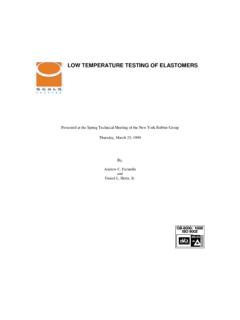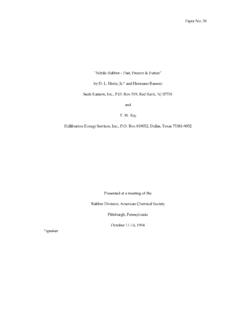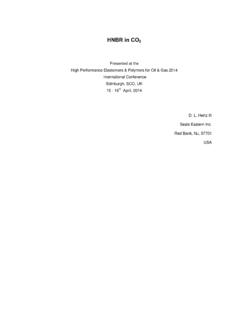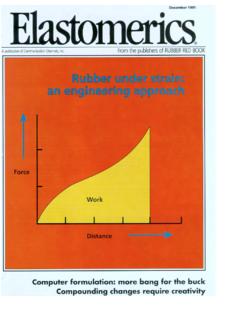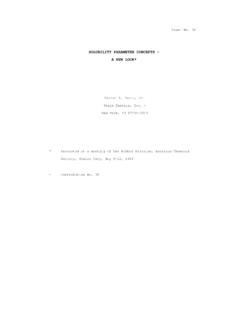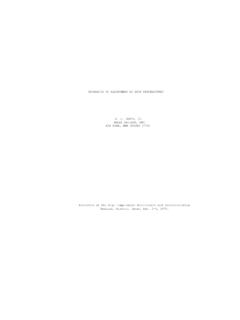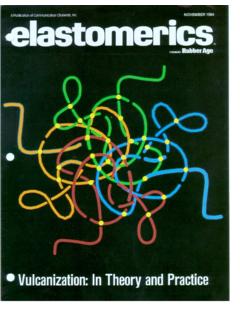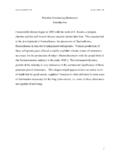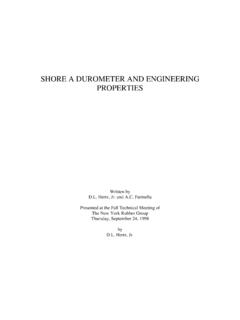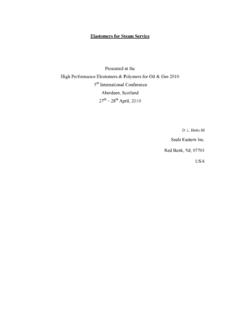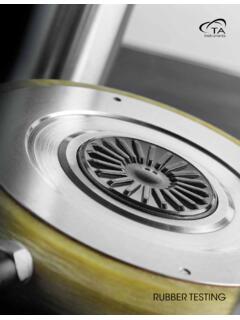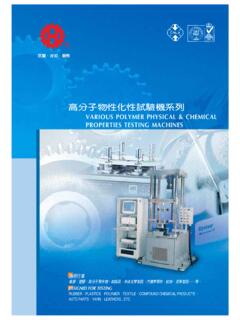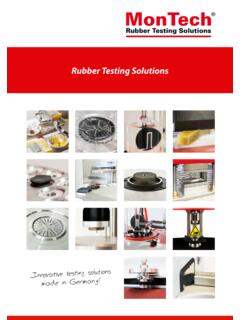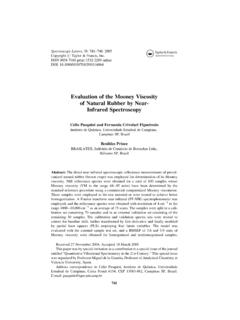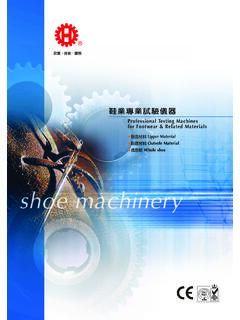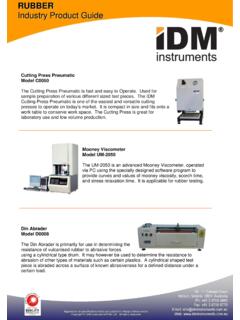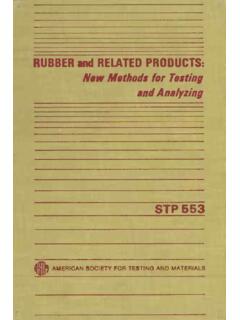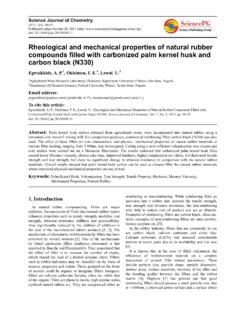Transcription of The Use of the MDR 2000 to Resolve a Problem in …
1 Paper No. 4 "The Use of the MDR 2000 to Resolve a Problem in injection molding " by Christopher Peacock* Hermann Bussem Daniel L. Hertz, Jr. Seals Eastern Inc. Red Bank, NJ Presented at a meeting of the rubber Division, American Chemical Society Louisville, Kentucky May 19-22, 1992 * speaker "The Use of The MDR2000E Rheometer to Resolve a Problem in injection molding " Abstract Converting a high-volume compression-molded bonded seal to an injection -molded process requires dramatically different rheological and curing properties of the elastomer formulation. Shear rates are orders of magnitude higher thus excluding typical rheometer and viscometer data. Compound development using the new Monsanto MDR2000E using tan , S' and S" values as well as the first derivative of S' (elastic modulus) with respect to time were reviewed for significant rheological characteristics.
2 Six low mooney nitrile (NBR) elastomers were tested and the results summarized. The same formulations will be reviewed by dynamic mechanical rheological testing (DMRT) in the paper by Dr. Alan Letton, Texas A&M. Introduction Compounding an elastomer for compression molding is relatively straight forward with the formulation easily tailored to the intricacy of the mold design. Compound quality control is readily monitored ; cure-rate and mix integrity, using an oscillating disc rheometer (ODR) and stock viscosity adequately monitored by a mooney viscometer . Mold release might be improved by incorporating some percentage of one of the many process aides available. Fig. la shows an actual control chart of a high-volume compression-molded bonded rubber part. Converting the same part over to a high-speed injection molding process is an entirely different set of conditions.
3 Once again, the use of a process aid "guaranteed to solve the flow Problem " and using a lower mooney polymer are the first steps typically tried. illustrates again the actual control chart in a factory trial for the similar part now molded in a high-speed molding press. The process incorporated screw plasticating injection of the formulation and a cold-runner platen system. The seal assembly is a typical configuration using a nitrile rubber elastomer, bonded to cold rolled steel stamping. Nitrile rubber (NBR) is the work horse oil-resistant elastomer of choice for typical sealing applications. A copolymer of butadiene and acrylonitrile (ACN), is produced by emulsion polymerization with the specifications defined by ACN level and mooney viscosity. The briefest review of these elastomers will point out that the structure (molecular architecture) is relatively complex.
4 The butadiene monomer copolymerizes into three distinct structures : trans, cis and 1,2-. The trans configuration, approximately 78% in a 28% ACN nitrile dominates, inevitably there will be blocks of these units. A 100% trans butadiene polymer would be a plastic (like gutta-percha in polyisoprene) hence these blocks are sensitive to heat in terms of shear thinning. The cis configuration, approximately 12% serves to break-up substantial crystallinity since it enters into a statistical pattern. 2 The 1,2- sites about 10% are free vinyl groups typically causing branching and often gel (insoluble polymer). The acrylonitrile (ACN) groups are inserted in a statistical pattern ranging from head-tail, head-head and tail-tail. It should be apparent by now that the molecular structure itself is rather complex without even the introduction of molecular weight variations, branching and gel.
5 Consider this elastomer now as used in a high-speed molding process: shear rates in terms of reciprocal seconds are several orders of magnitude higher than that produced in a viscometer . It is quite apparent that flow rates are well into the unstable region in terms of Reynold's number causing both flow-induced mixing and demixing of other ingredients. This flow-induced mixing and demixing creates additional problems due to phase separation of both the polymerization process residuals and possibly some compounding ingredients. All of this adds up to a substantial mold-fouling potential. This will reduce the time between mold cleaning and ultimately affecting not only productivity but also quality. The presence of ionic residuals left over from the polymerization process can be determined by aging a known weight of the elastomer gum in fluids of pH-4, pH-7 and pH-10 and recording weight change.
6 Illustrates this phenomena with swells ranging from a positive 13% to negative values. The negative values are created by the actual extraction of the ionic components. Keep in mind that a solution polymerized elastomer (as opposed to an emulsion polymerized) would have a positive swell in water under 1 %. mooney data is essentially useless since it is essentially a root mean-square average of everything (or anything). Values important to us are molecular weight and distribution, degree of branching, monomer distribution and, trans, cis and 1,2- ratios. Dynamic mechanical rheological testing (DMRT) offers us a wealth of information but the instrument is not typically found in a small to medium size rubber molding operation. 3 What we are trying to do is develop elastomer analysis capabilities using the new Monsanto MDR2000E.
7 This was achieved by accessing data via the RS232 port, building a spread sheet and developing curves for storage (elastic) modulus, first derivative of elastic modulus, viscous (loss) modulus and tan . Other more conventional data were tabulated looking for any correlation with DMRT data. Experimental Six (6) low- mooney (28-40) 34% ACN nitrile elastomers were compounded in the gum state with curatives only; cured 15' at 350OF Zinc oxide Stearic acid Sulfur MBTS This cure system will develop primarily polysulfidic crosslinks so dynamic properties of the base elastomer will be dominant rather than be influenced too strongly by the mechanically less mobile di- and monosulfidic crosslinks. Gel, if present would act as a filler and also tend to limit the die swell of an extrudate.
8 Conventional stress-strain data, engineering modulus (Young's) are reported as well as the MDR data are tabulated for discussion. Results and Discussions shows a substantial weight increase in the gum elastomer for samples A and D indicating a strong potential for mold fouling in injection molding . This was verified in factory trials so no further work is planned for these elastomers. Gel, if present will act as a filler as previously noted. Since all six samples were in the 34% ACN level, we can consider the following equation somewhat valid: G(shear modulus) = NkT = RT/Mc (1) lists E (Young's modulus) and since the samples are unfilled other than gel, E = 3G. In terms of gel content, based on stress-strain data, the samples showing increasing gel potential are B<F<C<A<D<E.
9 MDR data clearly shows differences in the crosslinked elastomers. Theoretically much of the data we seek has to be developed by studying stress versus time dependence. What we are looking for is some correlation with MDR data from crosslinked gum elastomers tested under a fixed strain versus fixed time. Essentially what is measured is terminal relaxation time, Ferry, in earlier edition (1) notes that under certain conditions this data can be obtained by looking at the ratio of G'/ 2 at very low frequencies. For the MDR, is approximately 10 radians/second. Fig. 4, measuring S' for the various samples shows some broad variations for elastomers having comparable Tg values (assuming a constant 34% ACN levels). Fig. 5, is the first derivative (dS'/dt) of Fig. 2 curves Based on these data, additional compound development is proceeding using Elastomer "C".
10 Summary The Pareto charts accompanying Figs. la & b illustrate that the injection molding process creates problems not typically associated with compression molding . The flow-induced mixing and demixing creates two potential conditions: a. mold fouling - due to polymerization residues demixing. improved mold-flow by use of a compatible process aid through a "plating out" phenomena. This same process can also interfere with the elastomer flow streams created by sprues, gates etc. causing potential "knitting" as well as bonding problems if metal details are incorporated. 5 The elastomer flow characteristics are strongly influenced by molecular architecture, branching & gel, and molecular weight distribution. In terms of S', S", tan and first derivative of S' as well as extractibles Elastomer "C" appears as the best candidate for this series.
